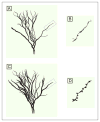KETAMINE'S MECHANISM OF ACTION: A PATH TO RAPID-ACTING ANTIDEPRESSANTS
- PMID: 27062302
- PMCID: PMC4961540
- DOI: 10.1002/da.22501
KETAMINE'S MECHANISM OF ACTION: A PATH TO RAPID-ACTING ANTIDEPRESSANTS
Abstract
Major depressive disorder (MDD) is a common and debilitating psychiatric disorder. Traditional antidepressants are of limited efficacy and take weeks to months to yield full therapeutic effects. Thus, there is a clear need for effective rapid-acting antidepressant medications. The N-methyl-d-aspartate receptor (NMDA-R) antagonist, ketamine, has received a great deal of attention over the last 20 years due to the discovery that a single subanesthetic dose leads to a rapid antidepressant effect in individuals with treatment-resistant depression. Animal and human research suggest that ketamine's antidepressant effects are mediated by a glutamate surge that leads to a cascade of events that result in synaptogenesis and reversal of the negative effects of chronic stress and depression, particularly within the prefrontal cortex (PFC). Preclinical and clinical data have provided compelling insights into the mechanisms underlying the rapid-acting antidepressant effects of ketamine. This review discusses stress-related neurobiology of depression and the safety, tolerability, and efficacy of ketamine for MDD, along with a review of ketamine's mechanism of action and prospective predictors of treatment response. Research limitations and future clinical prospects are also discussed.
Keywords: antidepressants; biological markers; depression; stress; treatment resistance.
© 2016 Wiley Periodicals, Inc.
Figures


Similar articles
-
Rapid-acting antidepressant ketamine, its metabolites and other candidates: A historical overview and future perspective.Psychiatry Clin Neurosci. 2019 Oct;73(10):613-627. doi: 10.1111/pcn.12902. Epub 2019 Jul 11. Psychiatry Clin Neurosci. 2019. PMID: 31215725 Free PMC article. Review.
-
A review of ketamine in affective disorders: current evidence of clinical efficacy, limitations of use and pre-clinical evidence on proposed mechanisms of action.J Affect Disord. 2014 Mar;156:24-35. doi: 10.1016/j.jad.2013.11.014. Epub 2013 Dec 10. J Affect Disord. 2014. PMID: 24388038 Review.
-
Ketamine: The final frontier or another depressing end?Behav Brain Res. 2020 Apr 6;383:112508. doi: 10.1016/j.bbr.2020.112508. Epub 2020 Feb 1. Behav Brain Res. 2020. PMID: 32017978 Free PMC article. Review.
-
What is the mechanism of Ketamine's rapid-onset antidepressant effect? A concise overview of the surprisingly large number of possibilities.J Clin Pharm Ther. 2017 Apr;42(2):147-154. doi: 10.1111/jcpt.12497. Epub 2017 Jan 22. J Clin Pharm Ther. 2017. PMID: 28111761 Review.
-
Glutamate receptor antagonists as fast-acting therapeutic alternatives for the treatment of depression: ketamine and other compounds.Annu Rev Pharmacol Toxicol. 2014;54:119-39. doi: 10.1146/annurev-pharmtox-011613-135950. Annu Rev Pharmacol Toxicol. 2014. PMID: 24392693 Free PMC article. Review.
Cited by
-
TAARs as Novel Therapeutic Targets for the Treatment of Depression: A Narrative Review of the Interconnection with Monoamines and Adult Neurogenesis.Biomedicines. 2024 Jun 6;12(6):1263. doi: 10.3390/biomedicines12061263. Biomedicines. 2024. PMID: 38927470 Free PMC article. Review.
-
BMS-986163, a Negative Allosteric Modulator of GluN2B with Potential Utility in Major Depressive Disorder.ACS Med Chem Lett. 2018 Apr 13;9(5):472-477. doi: 10.1021/acsmedchemlett.8b00080. eCollection 2018 May 10. ACS Med Chem Lett. 2018. PMID: 29795762 Free PMC article.
-
A Circadian Genomic Signature Common to Ketamine and Sleep Deprivation in the Anterior Cingulate Cortex.Biol Psychiatry. 2017 Sep 1;82(5):351-360. doi: 10.1016/j.biopsych.2017.02.1176. Epub 2017 Mar 1. Biol Psychiatry. 2017. PMID: 28395871 Free PMC article.
-
The Role of Central Serotonin Neurons and 5-HT Heteroreceptor Complexes in the Pathophysiology of Depression: A Historical Perspective and Future Prospects.Int J Mol Sci. 2021 Feb 15;22(4):1927. doi: 10.3390/ijms22041927. Int J Mol Sci. 2021. PMID: 33672070 Free PMC article. Review.
-
Preclinical toxicological study of prolonged exposure to ketamine as an antidepressant.Pharmacol Rep. 2020 Feb;72(1):24-35. doi: 10.1007/s43440-019-00014-z. Epub 2019 Dec 20. Pharmacol Rep. 2020. PMID: 32016837
References
-
- Kessler RC, Berglund P, Demler O, et al. Lifetime prevalence and age-of-onset distributions of DSM-IV disorders in the National Comorbidity Survey Replication. Arch Gen Psychiatry. 2005;62(6):593–602. - PubMed
-
- Rush AJ, Trivedi MH, Wisniewski SR, et al. Acute and longer-term outcomes in depressed outpatients requiring one or several treatment steps: a STAR*D report. Am J Psychiatry. 2006;163(11):1905–17. - PubMed
-
- Katz MM, Tekell JL, Bowden CL, et al. Onset and early behavioral effects of pharmacologically different antidepressants and placebo in depression. Neuropsychopharmacology. 2004;29(3):566–79. - PubMed
Publication types
MeSH terms
Substances
Grants and funding
LinkOut - more resources
Full Text Sources
Other Literature Sources
Medical
Miscellaneous

